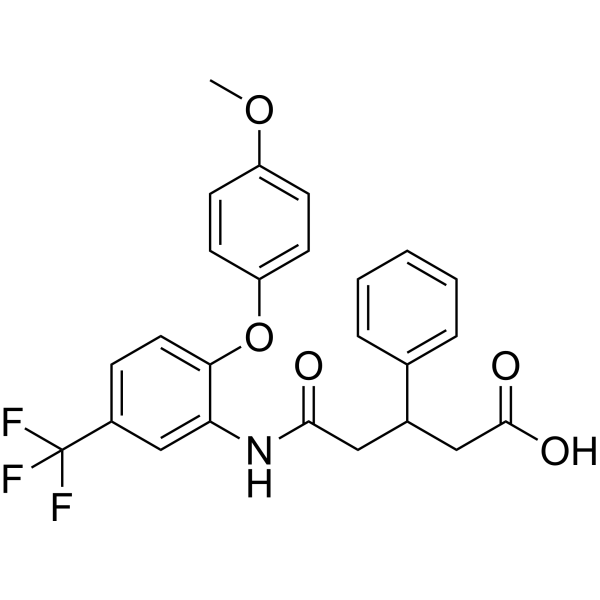Physicochemical Properties
| Molecular Formula | C25H22F3NO5 |
| Molecular Weight | 473.441097736359 |
| Exact Mass | 473.145 |
| CAS # | 698346-43-9 |
| PubChem CID | 2812813 |
| Appearance | White to off-white solid powder |
| LogP | 4.7 |
| Hydrogen Bond Donor Count | 2 |
| Hydrogen Bond Acceptor Count | 8 |
| Rotatable Bond Count | 9 |
| Heavy Atom Count | 34 |
| Complexity | 659 |
| Defined Atom Stereocenter Count | 0 |
| SMILES | N(C1C=C(C(F)(F)F)C=CC=1OC1C=CC(OC)=CC=1)C(=O)CC(C1C=CC=CC=1)CC(=O)O |
| InChi Key | UMUXAMJXLBOQNN-UHFFFAOYSA-N |
| InChi Code | InChI=1S/C25H22F3NO5/c1-33-19-8-10-20(11-9-19)34-22-12-7-18(25(26,27)28)15-21(22)29-23(30)13-17(14-24(31)32)16-5-3-2-4-6-16/h2-12,15,17H,13-14H2,1H3,(H,29,30)(H,31,32) |
| Chemical Name | 5-[2-(4-methoxyphenoxy)-5-(trifluoromethyl)anilino]-5-oxo-3-phenylpentanoic acid |
| HS Tariff Code | 2934.99.9001 |
| Storage |
Powder-20°C 3 years 4°C 2 years In solvent -80°C 6 months -20°C 1 month |
| Shipping Condition | Room temperature (This product is stable at ambient temperature for a few days during ordinary shipping and time spent in Customs) |
Biological Activity
| ln Vitro | In renal tubular epithelial cells, 84-B10 (10-100 μM; 2 h) suppresses ferroptosis caused by cisplatin in a dose-dependent manner [1]. The mitochondrial structural damage and dysfunction caused by cisplatin are restored by 84-B10 (40 μM; 2 hours; TKPT cells) [1]. 84-B10 (40 μM; 2 hours; TKPT cells) attenuates oxidative stress caused by mtROS in cisplatin-induced acute kidney injury [1]. By removing mtROS and reestablishing mitochondrial homeostasis, 84-B10 (40 μM; 2 hours; TKPT cells) reduces the damage that cisplatin causes to epithelial cells [1]. |
| ln Vivo | In mice, 84-B10 (5–15 mg/kg; ip) lessens acute renal damage caused by cisplatin [1]. |
| Cell Assay |
Western Blot Analysis[1] Cell Types: tubular epithelial cell Tested Concentrations: 10, 20, 30, 40, 50, and 100 μM Incubation Duration: 2 hrs (hours) Experimental Results: Increased the levels of NRF2, SLC7A11, and GPX4 in a dose-dependent manner. Western Blot Analysis[1] Cell Types: TKPT cells Tested Concentrations: 40 μM Incubation Duration: 2 hrs (hours) Experimental Results: Increased the levels of OM Porins, IMS Cyt c, IM CVa, IM Core 1, and Matrix CypD in a dose-dependent manner. |
| Animal Protocol |
Animal/Disease Models: Male C57BL/6 mice with acute kidney injury[1] Doses: 5, 10, and 15 mg/kg Route of Administration: intraperitoneal (ip)injection Experimental Results: diminished the sCr and BUN levels of cisplatin-exposed mice. Attenuated renal tubules morphological abnormalities in a dose-dependent manner. diminished NGAL and KIM-1 levels in a dose-dependent manner. diminished the transcription levels of Lcn2 (which encodes NGAL) and Havcr1 . |
| References |
[1]. A novel 3-phenylglutaric acid derivative (84-B10) alleviates cisplatin-induced acute kidney injury by inhibiting mitochondrial oxidative stress-mediated ferroptosis. Free Radic Biol Med. 2023 Jan;194:84-98. |
Solubility Data
| Solubility (In Vitro) |
DMSO : 100 mg/mL (211.22 mM) H2O : < 0.1 mg/mL |
| Solubility (In Vivo) |
Solubility in Formulation 1: ≥ 1.25 mg/mL (2.64 mM) (saturation unknown) in 10% DMSO + 40% PEG300 + 5% Tween80 + 45% Saline (add these co-solvents sequentially from left to right, and one by one), clear solution. For example, if 1 mL of working solution is to be prepared, you can add 100 μL of 12.5 mg/mL clear DMSO stock solution to 400 μL PEG300 and mix evenly; then add 50 μL Tween-80 to the above solution and mix evenly; then add 450 μL normal saline to adjust the volume to 1 mL. Preparation of saline: Dissolve 0.9 g of sodium chloride in 100 mL ddH₂ O to obtain a clear solution. Solubility in Formulation 2: ≥ 1.25 mg/mL (2.64 mM) (saturation unknown) in 10% DMSO + 90% (20% SBE-β-CD in Saline) (add these co-solvents sequentially from left to right, and one by one), clear solution. For example, if 1 mL of working solution is to be prepared, you can add 100 μL of 12.5 mg/mL clear DMSO stock solution to 900 μL of 20% SBE-β-CD physiological saline solution and mix evenly. Preparation of 20% SBE-β-CD in Saline (4°C,1 week): Dissolve 2 g SBE-β-CD in 10 mL saline to obtain a clear solution. Solubility in Formulation 3: ≥ 1.25 mg/mL (2.64 mM) (saturation unknown) in 10% DMSO + 90% Corn Oil (add these co-solvents sequentially from left to right, and one by one), clear solution. For example, if 1 mL of working solution is to be prepared, you can add 100 μL of 12.5 mg/mL clear DMSO stock solution to 900 μL of corn oil and mix evenly. (Please use freshly prepared in vivo formulations for optimal results.) |
| Preparing Stock Solutions | 1 mg | 5 mg | 10 mg | |
| 1 mM | 2.1122 mL | 10.5610 mL | 21.1220 mL | |
| 5 mM | 0.4224 mL | 2.1122 mL | 4.2244 mL | |
| 10 mM | 0.2112 mL | 1.0561 mL | 2.1122 mL |
